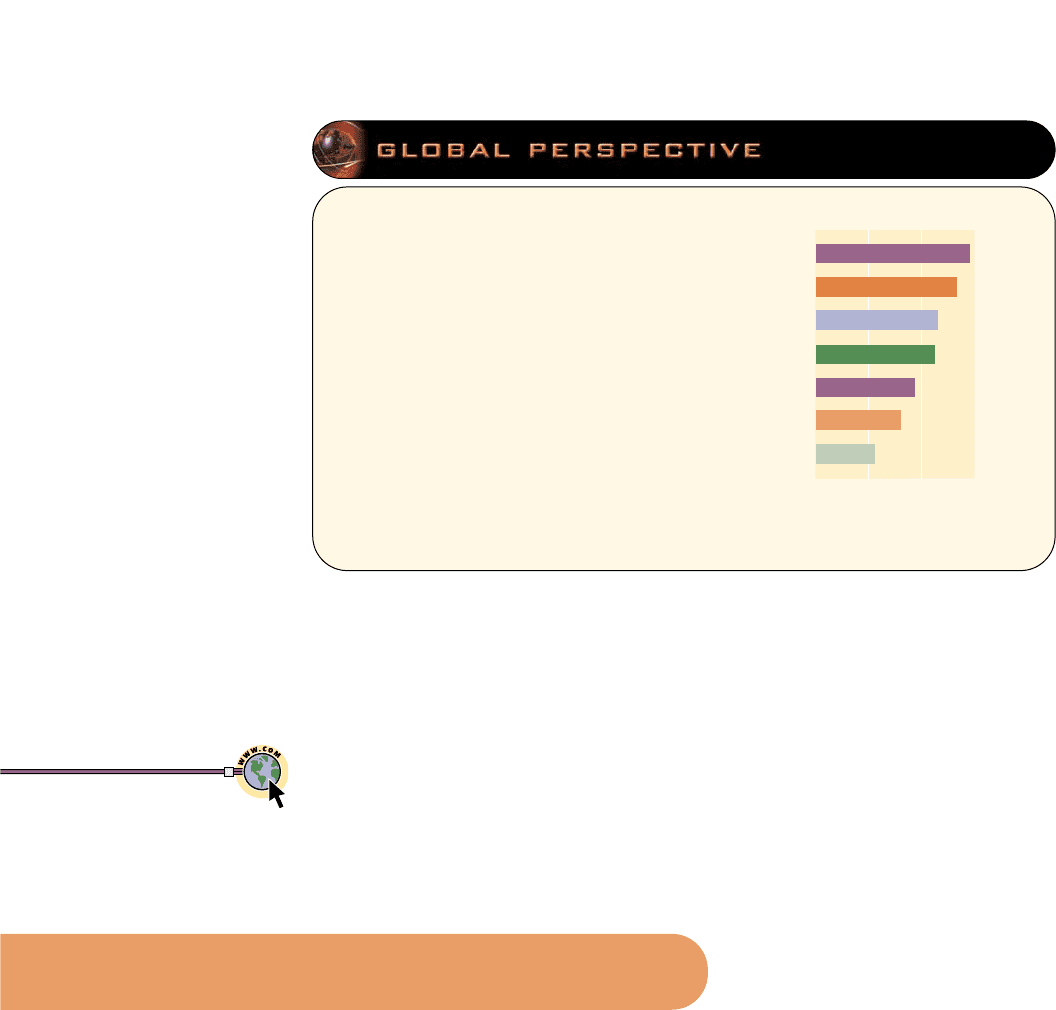McConnell Campbell R., Brue Stanley L., Barbiero Thomas P. Microeconomics. Ninth Edition
Подождите немного. Документ загружается.


300 Part Two • Microeconomics of Product Markets
may now constitute a significant
barrier to entry.
Blindfold taste tests confirm
that most mass-produced Cana-
dian beers taste alike, so, brew-
ers greatly emphasize advertis-
ing. Here, Labatt and Molson,
who sell national brands, enjoy
major cost advantages over pro-
ducers that have regional brands
(for example, Creemore Springs,
Upper Canada, and Okanagan
Spring). The reason is because
national television advertising is
less costly per viewer than local
spot TV advertising.
Mergers in the brewing in-
dustry have been a fundamental
cause of the rising concentra-
tion. Dominant firms have ex-
panded by heavily advertising
their main brands such as Labatt
Blue, Molson Canadian, Blue
Light, Canadian Light, and Mol-
son Special Dry, sustaining sig-
nificant product differentiation
despite the declining number of
major brewers.
Two factors dominate the
Canadian beer industry: high
transportation costs and provin-
cial policies and practices. High
transportation costs have trans-
lated into a regional structure of
production compared with the
brewing industry in the United
States. As a consequence, a large
number of breweries exist in
Canada relative to the size of the
domestic market. Especially out-
side the larger breweries in On-
tario and Quebec, unit costs are
markedly higher because of the
inability to achieve economies of
scale.
Even more important than
transportation costs, provincial
policies and practices in the past
had a dominant impact on the
Canadian brewing industry; until
recently, brewers were not al-
lowed to transport beer produced
in one province to be sold in an-
other. This restriction has now
been relaxed, and brewers will
centralize operations in the future
to capture economies of scale.
Imported beers such as Beck,
Corona, Foster’s, and Guinness
constitute over 10 percent of the
Canadian market, with individ-
ual brands seeming to wax and
wane in popularity. Some local
or regional microbreweries such
as Upper Canada (purchased re-
cently by Sleeman), which brew
specialty beers and charge pre-
mium prices, have whittled into
the sales of the major brewers.
Labatt and Molson have taken
notice, responding with spe-
cialty brands of their own (for
example, John Labatt Classic
and Molson Signature Spring
Bock). Overall, however, it ap-
pears that imports such as
Heineken and Budweiser may
pose more of a threat to the ma-
jors than the microbreweries do.
Sources: Based on Kenneth G.
Elzinga, “Beer,” in Walter Adams
and James Brock (eds.), The Struc-
ture of American Industry, 9th ed.
(Englewood Cliffs, NJ: Prentice-Hall,
1995), pp. 119–151; Douglas F. Greer,
“Beer: Causes of Structural Change,”
in Larry Duetsch (ed.), Industry
Studies, 2nd ed. (New York: M. E.
Sharpe, 1998), pp. 28–64; authors’
updates; the Conference Board of
Canada, The Canadian Brewing
Industry: Historical Evolution and
Competitive Structure (Toronto: Inter-
national Studies and Development
Group, 1989).
chapter summary
1. The distinguishing features of monopolistic
competition are (a) enough firms are in the
industry to ensure that each firm has only
limited control over price, mutual interde-
pendence is absent, and collusion is nearly
impossible; (b) products are characterized by
real or perceived differences so that eco-
nomic rivalry entails both price and nonprice
competition; and (c) entry to the industry is
relatively easy. Many aspects of retailing,
and some manufacturing industries in which
economies of scale are few, approximate
monopolistic competition.
2. Monopolistically competitive firms may earn
economic profits or incur losses in the short
run. The easy entry and exit of firms result in
only normal profits in the long run.
3. The long-run equilibrium position of the
monopolistically competitive producer is
less socially desirable than that of the pure
competitor. Under monopolistic competition,

chapter eleven • monopolistic competition and oligopoly 301
price exceeds marginal cost, suggesting an
underallocation of resources to the product,
and price exceeds minimum average total
cost, indicating that consumers do not get
the product at the lowest price that cost con-
ditions might allow.
4. Nonprice competition provides a means by
which monopolistically competitive firms
can offset the long-run tendency for eco-
nomic profit to fall to zero. Through product
differentiation, product development, and
advertising, a firm may strive to increase the
demand for its product more than enough to
cover the added cost of such nonprice com-
petition. Consumers benefit from the wide
diversity of product choice that monopolistic
competition provides.
5. In practice, the monopolistic competitor
seeks the specific combination of price, prod-
uct, and advertising that will maximize profit.
6. Oligopolistic industries are characterized by
the presence of few firms, each having a sig-
nificant fraction of the market. Firms thus
situated are mutually interdependent: the
behaviour of any one firm directly affects,
and is affected by, the actions of rivals. Prod-
ucts may be either virtually uniform or sig-
nificantly differentiated. Various barriers to
entry, including economies of scale, underlie
and maintain oligopoly.
7. Concentration ratios are a measure of oli-
gopoly (monopoly) power. By giving more
weight to larger firms, the Herfindahl index
is designed to measure market dominance in
an industry.
8. Game theory (a) shows the interdependence
of oligopolists’ pricing policies; (b) reveals
the tendency of oligopolists to collude; and
(c) explains the temptation of oligopolists to
cheat on collusive arrangements.
9. Noncollusive oligopolists may face a kinked-
demand curve. This curve and the accompa-
nying marginal-revenue curve help explain
the price rigidity that often characterizes
oligopolies; they do not, however, explain
how the actual prices of products are first
established.
10. The uncertainties inherent in oligopoly pro-
mote collusion. Collusive oligopolists such
as cartels maximize joint profits—that is,
they behave like pure monopolists. Demand
and cost differences, a large number of
firms, cheating through secret price conces-
sions, recessions, and the anti-combines
laws are all obstacles to collusive oligopoly.
11. Price leadership is an informal means of col-
lusion whereby one firm, usually the largest
or most efficient, initiates price changes and
the other firms in the industry follow the
leader.
12. Market shares in oligopolistic industries are
usually determined based on product de-
velopment and advertising. Oligopolists
emphasize nonprice competition because
(a) advertising and product variations are
harder for rivals to match and (b) oligopo-
lists frequently have ample resources to
finance nonprice competition.
13. Advertising may affect prices, competition,
and efficiency either positively or negatively.
Positive: It can provide consumers with low-
cost information about competing products,
help introduce new competing products
into concentrated industries, and generally
reduce monopoly power and its attendant
inefficiencies. Negative: It can promote
monopoly power via persuasion and the cre-
ation of entry barriers. Moreover, it can be
self-cancelling when engaged in by rivals
by boosting costs and increasing economic
inefficiency while accomplishing little else.
14. Neither productive nor allocative efficiency
is realized in oligopolistic markets, but oli-
gopoly may be superior to pure competition
in promoting research and development and
technological progress.
terms and concepts
monopolistic competition,
p. 274
product differentiation, p. 274
nonprice competition, p. 276
excess capacity, p. 281
oligopoly, p. 282
homogeneous oligopoly, p. 283
differentiated oligopoly, p. 283
mutual interdependence, p. 283
concentration ratio, p. 284
interindustry competition,
p. 285
import competition, p. 285
Herfindahl index, p. 285
game theory model, p. 286
collusion, p. 287
kinked-demand curve, p. 288
price war, p. 291
cartel, p. 292
tacit understandings, p. 293
price leadership, p. 295

302 Part Two • Microeconomics of Product Markets
study questions
1. How does monopolistic competition differ
from pure competition in its basic character-
istics? from pure monopoly? Explain fully
what product differentiation may involve.
Explain how the entry of firms into its in-
dustry affects the demand curve facing a
monopolistic competitor and how that, in
turn, affects its economic profit.
2.
KEY QUESTION Compare the elastic-
ity of the monopolistic competitor’s demand
with that of a pure competitor and a pure
monopolist. Assuming identical long-run
costs, compare graphically the prices and out-
puts that would result in the long run under
pure competition and under monopolistic
competition. Contrast the two market struc-
tures in terms of productive and allocative
efficiency. Explain: “Monopolistically compet-
itive industries are characterized by too many
firms, each of which produces too little.”
3. “Monopolistic competition is monopolistic
up to the point at which consumers become
willing to buy close-substitute products and
competitive beyond that point.” Explain.
4. “Competition in quality and service may be
just as effective as price competition in giv-
ing buyers more for their money.” Do you
agree? Why? Explain why monopolistically
competitive firms frequently prefer nonprice
competition to price competition.
5. Critically evaluate and explain:
a. “In monopolistically competitive indus-
tries, economic profits are competed
away in the long run; hence, there is no
valid reason to criticize the performance
and efficiency of such industries.”
b. “In the long run, monopolistic competi-
tion leads to a monopolistic price but not
to monopolistic profits.”
6. Why do oligopolies exist? List five or six oli-
gopolists whose products you own or regu-
larly purchase. What distinguishes oligopoly
from monopolistic competition?
7.
KEY QUESTION Answer the follow-
ing questions, which relate to measures of
concentration:
a. What is the meaning of a four-firm con-
centration ratio of 60 percent? 90 percent?
What are the shortcomings of concen-
tration ratios as measures of monopoly
power?
b. Suppose that the five firms in industry A
have annual sales of 30, 30, 20, 10, and 10
percent of total industry sales. For the
five firms in industry B the figures are
60, 25, 5, 5, and 5 percent. Calculate the
Herfindahl index for each industry and
compare their likely competitiveness.
8.
KEY QUESTION Explain the general
meaning of the following payoff matrix for
oligopolists C and D. All profit figures are in
thousands.
a. Use the payoff matrix to explain the
mutual interdependence that character-
izes oligopolistic industries.
b. Assuming no collusion between C and D,
what is the likely pricing outcome?
c. In view of your answer to 8b, explain why
price collusion is mutually profitable.
Why might a temptation to cheat on the
collusive agreement exist?
9.
KEY QUESTION What assumptions
about a rival’s response to price changes
underlie the kinked-demand curve for oli-
gopolists? Why is there a gap in the oligop-
olist’s marginal-revenue curve? How does
the kinked-demand curve explain price rigid-
ity in oligopoly? What are the shortcomings
of the kinked-demand model?
10. Why might price collusion occur in oligopo-
listic industries? Assess the economic desir-
ability of collusive pricing. What are the
main obstacles to collusion? Discuss the
weakening of OPEC in the 1980s in terms of
those obstacles.
11.
KEY QUESTION Why is there so
much advertising in monopolistic competi-
tion and oligopoly? How does such advertis-
ing help consumers and promote efficiency?
Why might it be excessive at times?
High
$60
Low
$57
$55
$59
$69
$50
$58
$55
High Low
C's possible prices
D's possible prices

chapter eleven • monopolistic competition and oligopoly 303
internet application questions
1. Indigo at <www.indigo.ca> is Canada’s
largest online bookseller, but it still has to
compete with the very popular Amazon at
<www.amazon.com>. Search both sites for
Viktor Frankl’s Man’s Search for Meaning (in
paperback). Find the price and determine
which company sells the book at a lower
price (convert Amazon’s price into Canadian
dollars using the current exchange rate at
Yahoo’s financial site, <finance.yahoo.com/
m3?u>. Identify the nonprice competition
that might lead you to order from one com-
pany rather than the other.
2. Advertising Age at <adageglobal.com/cgi-bin/
pages.pl?link=428> compiles statistics on
the large advertisers and advertisements
categories. Go to Ad Age Data Base to find
information on Canadian advertising. Which
ad category has the largest spending? What
is the biggest circulation magazine? How
much does an entire black and white page
advertisement cost in that magazine?
12. (Advanced analysis) Construct a game the-
ory matrix involving two firms and their
decisions on high versus low advertising
budgets and the effects of each on profits.
Show a circumstance in which both firms
select high advertising budgets even though
both would be more profitable with low
advertising budgets. Why won’t they unilat-
erally cut their advertising budget?
13. (The Last Word) What firm(s) dominate the
beer industry? What demand and supply fac-
tors have contributed to the small number of
firms in this industry?

IN THIS CHAPTER
IN THIS CHAPTER
Y
Y
OU WILL LEARN:
OU WILL LEARN:
To distinguish among an
invention, an innovation,
and technological diffusion.
•
About the role of entrepreneurs
and other innovators.
•
A firm’s optimal amount of R&D.
•
About the role of market
structure on technological change.
•
How technological advance
enhances both productive
and allocative efficiency.
•
About consumer surplus
and producer surplus.
Technology,
R&D, and
Efficiency
J
ust do it! In 1968 two entrepreneurs
in Oregon developed a lightweight
sport shoe and formed a new company
called Nike, incorporating a “swoosh” logo
(designed by a graduate student for $35).
Today, Nike employs more than 20,000 work-
ers and sells more than U.S.$9 billion worth
of athletic shoes, hiking boots, and sports
apparel annually.
“Intel inside.” Intel? In 1967 neither this
company nor its product existed. Today, it is
the world’s largest producer of microproces-
sors for personal computers, with 67,500
employees and more than U.S.$29 billion in
annual sales.
TWELVE

Nortel Networks, headquartered in Brampton, Ontario, has become the largest
optical fibre manufacturer in the world. Optical fibres allow much faster transmis-
sion of electronic data, which increases the speed of Internet connections.
In 1996 Palm introduced its Palm Pilot, a palm-sized personal computer that now
also has wireless Internet capabilities. A novel idea? Apparently, so: Microsoft, Hand-
spring, OmniSky, and others have followed with similar products, and cell phone
makers are incorporating Internet functionality into some of their new phones.
Each of these brief descriptions entails some elements of technological advance,
broadly defined as new and better goods and services and new and better ways of
producing or distributing them. In this chapter, we want to look at some of the
microeconomics of technological advance. Who motivates and implements techno-
logical advance? What determines a firm’s optimal amount of research and devel-
opment (R&D)? What is the extent and implications of the imitation problem that
innovators face? Are certain market structures more conducive to technological
advance than others? How does technological advance relate to efficiency? These
are some of the questions we address in this chapter. We also take another look at
allocative and productive efficiency and investigate another way to measure them.
For economists, technological advance occurs over a theoretical time period called
the very long run, which can be as short as a few months or as long as many years.
Recall that in our four market models (pure competition, monopolistic competition,
oligopoly, and pure monopoly), the short run is a period in which technology, plant,
and equipment are fixed; in the long run, technology is constant but firms can
change their plant sizes and are free to enter or exit industries. In contrast, the very
long run is a period in which technology can change and in which firms can develop
and offer entirely new products.
In Chapter 2 we saw that technological advance shifts an economy’s produc-
tion possibilities curve outward, enabling the economy to obtain more goods and
services. Technological advance is a three-step process of invention, innovation, and
diffusion.
Invention
The basis of technological advance is invention: the discovery of a product or process
through the use of imagination, ingenious thinking, and experimentation and the first proof
that it will work. Invention is a process, and the result of the process is also called an
invention. The prototypes (basic working models) of the telephone, the automobile,
and the microchip are inventions. Invention usually is based on scientific knowl-
edge and is the product of individuals, either working on their own or as members
of corporate R&D staffs. Later on you will see how governments encourage inven-
tion by providing the inventor with a patent, an exclusive right to sell any new and
useful process, machine, or product for a set time.
Innovation
Innovation draws directly on invention. While invention is the “discovery and first
proof of workability,” innovation is the first successful commercial introduction
of a new product, the first use of a new method, or the creation of a new form of
chapter twelve • technology, r&d, and efficiency 305
techno-
logical
advance
New
and better goods
and services and
new and better
ways of producing
or distributing them.
very long
run
A period in
which technology
can change and
in which firms
can develop and
offer entirely new
products.
invention
The discovery of a
product or process
through the use of
imagination, ingen-
ious thinking, and
experimentation
and the first proof
that it will work.
patent An
exclusive right to
sell any new and
useful process,
machine, or product
for a set time.
innovation
The first successful
commercial intro-
duction of a new
product, the first use
of a new method of
production, or the
creation of a new
form of business
organization.
Technological Advance: Invention,
Innovation, and Diffusion

business organization. Innovation is of two types: product innovation, which refers
to new and improved products or services; and process innovation, which refers to
new and improved methods of production or distribution.
Unlike inventions, innovations cannot be patented. Nevertheless, innovation is a
major factor in competition, since it sometimes enables a firm to leapfrog competi-
tors by rendering their products or processes obsolete. For example, personal com-
puters coupled with software for word processing pushed some major typewriter
manufacturers into obscurity. More recently, innovations in hardware retailing
(large warehouse stores such as Home Depot) have threatened the existence of
smaller, more traditional hardware stores.
Innovation need not weaken or destroy existing firms. Aware that new products
and processes may threaten their survival, existing firms have a powerful incentive
to engage continually in R&D of their own. Innovative products and processes often
enable such firms to maintain or increase their profits. The introduction of alu-
minum cans by Reynolds, disposable contact lenses by Johnson & Johnson, and sci-
entific calculators by Hewlett-Packard are good examples. Thus, innovation can
either diminish or strengthen market power.
Diffusion
Diffusion is the spread of an innovation through imitation or copying. To take
advantage of new profit opportunities or to slow the erosion of profit, both new and
existing firms emulate the successful innovations of others. Years ago McDonald’s
successfully introduced the fast-food hamburger; Burger King, Swiss Chalet, and
other firms soon copied that idea. Hertz greatly increased its auto rentals by offer-
ing customers unlimited mileage, and Avis, Budget, and others eventually fol-
lowed. DaimlerChrysler profitably introduced a luxury version of its Jeep Grand
Cherokee; other manufacturers, including Acura, Mercedes, and Lexus, countered
with luxury sport-utility vehicles of their own. In each of these cases, innovation has
led eventually to widespread imitation—that is, to diffusion.
R&D Expenditures
As related to businesses, the term “research and development” is used loosely to
include direct efforts toward invention, innovation, and diffusion. However, gov-
ernment also engages in R&D, particularly R&D having to do national defence. In
1999 total Canadian R&D expenditures (business plus government) were $12 billion.
Relative to GDP, that amount was 1.6 percent, which is a reasonable measure of the
emphasis the Canadian economy puts on technological advance. As shown in
Global Perspective 12.1, this is a relatively low percentage of GDP compared to sev-
eral other nations.
Modern View of Technological Advance
For decades most economists regarded technological advance as being external to
the economy—a random outside force to which the economy adjusted. Periodically
fortuitous advances in scientific and technological knowledge occurred, paving the
way for major new products (automobiles, airplanes) and new production processes
(assembly lines). Firms and industries, each at its own pace, then incorporated the
new technology into their products or processes to enhance or maintain their profit.
Then after making the appropriate adjustments, they settled back into new long-run
equilibrium positions. Although technological advance has been vitally important
306 Part Two • Microeconomics of Product Markets
product
innovation
The development
and sale of a new or
improved product
or service.
process
innovation
The development
and use of new or
improved produc-
tion or distribution
methods.
diffusion
The widespread
imitation of an
innovation.

to the economy, economists believed it was rooted in the independent advance of
science, which is largely external to the market system.
Most contemporary economists have a different view. They see capitalism itself
as the driving force of technological advance. In their view, invention, innovation,
and diffusion occur in response to incentives within the economy, meaning that
technological advance is internal to capitalism. Specifically, technological advance
arises from intense rivalry among individuals and firms that motivates them to seek
and exploit new profit opportunities or to expand existing opportunities. That
rivalry occurs both among existing firms and between existing firms and new firms.
Moreover, many advances in pure scientific knowledge are motivated, at least in
part, by the prospect of commercial applicability and eventual profit. In the modern
view, entrepreneurs and other innovators are at the heart of technological advance.
It will be helpful to distinguish between entrepreneurs and other innovators:
● Entrepreneurs Recall that the entrepreneur is an initiator, innovator, and risk
bearer—the catalyst who combines land, labour, and capital resources in new
and unique ways to produce new goods and services. In the past a single indi-
vidual, for example, Hart Massey in farm machinery, Henry Ford in automo-
biles, and Levi Strauss in blue jeans, carried out the entrepreneurial role. Such
advances as air conditioning, the ballpoint pen, cellophane, the jet engine,
insulin, xerography, and the helicopter all have an individualistic heritage. But
in today’s more technologically complex economy, entrepreneurship is just as
likely to be carried out by entrepreneurial teams. Such teams may include only
two or three people working as their own bosses on some new product or idea,
or it may consist of larger groups of entrepreneurs who have pooled their
financial resources.
chapter twelve • technology, r&d, and efficiency 307
Total R&D expenditures
as a percentage of GDP,
selected nations 1999
Relative R&D spending varies
among the seven leading
industrial nations. From a
microeconomic perspective,
R&D helps promote economic
efficiency; from a macroeco-
nomic perspective, R&D helps
promote economic growth.
12.1
0123
Japan
United States
Canada
Germany
France
United Kingdom
Italy
Source: National Science Foundation, <www.nsf.gov>.
<www.interlog.com/
~womenip/>
Women inventors
project
Role of Entrepreneurs and
Other Innovators

● Other innovators This designation includes other key people involved in the
pursuit of innovation who do not bear personal financial risk. Among them are
key executives, scientists, and other salaried employees engaged in commer-
cial R&D activities. (They are sometimes referred to as intrapreneurs, since they
provide the spirit of entrepreneurship within existing firms.)
Forming Start-Ups
Entrepreneurs often form small new companies called start-ups that focus on cre-
ating and introducing a new product or employing a new production or distribu-
tion technique. Two people, working out of their garages, formed such a start-up in
the mid-1970s. Since neither of their employers—Hewlett-Packard and Atari, the
developer of Pong (the first video game)—was interested in their prototype per-
sonal computer, they founded their own company: Apple Computers. Other exam-
ples of successful start-ups are Amgen, a biotechnology firm specializing in new
medical treatments; Second Cup, a seller of gourmet coffee; and Corel, which devel-
ops innovative graphics software.
Innovating within Existing Firms
Innovators are also at work within existing corporations, large and small. Such inno-
vators are salaried workers, though many firms have pay systems that provide them
with substantial bonuses or shares of the profit. Examples of firms known for their
skillful internal innovators are the 3M Corporation, the U.S. developer of Scotch
tape, Post-it Notes, and Thinsulate insulation; and Canon, the Japanese developer
of the laser engine for personal copiers and printers. R&D work in major corpora-
tions has produced significant technological improvements in such products as tel-
evision sets, telephones, home appliances, automobiles, automobile tires, and
sporting equipment.
Some large firms, aware that excessive bureaucracy can stifle creative thinking and
technological advance, have split part of their R&D and manufacturing divisions to
form new, more flexible, innovative firms. One significant example of such a spinoff
firm is Nortel, a telephone equipment and R&D firm created by Bell Canada.
Anticipating the Future
Some 50 years ago a writer for Popular Mechanics magazine boldly predicted, “Com-
puters in the future may weigh no more than 1.5 tons.” Today’s notebook comput-
ers weigh less than two kilograms. It is difficult to anticipate the future, but that is
what innovators try to do. Those with strong anticipatory ability and determination
have a knack for introducing new and improved products or services at just the
right time. The rewards are both monetary and nonmonetary. Product innovation
and development are creative endeavours, with such intangible rewards as personal
satisfaction. Also, many people simply enjoy participating in the competitive con-
test. Of course, the winners can reap huge monetary rewards in the form of eco-
nomic profits, stock appreciation, or large bonuses. Extreme examples are Bill Gates
and Paul Allen, who founded Microsoft in 1975 and had a net worth in 2000 of U.S.$85
billion and U.S.$40 billion, respectively, mainly in the form of Microsoft stock.
Past successes often give entrepreneurs and innovative firms access to resources
for further innovations that anticipate consumer wants. Although they may not suc-
ceed a second time, the market tends to entrust the production of goods and serv-
308 Part Two • Microeconomics of Product Markets
start-ups
Small new com-
panies that focus
on creating and
introducing a new
product or employ-
ing a new produc-
tion or distribution
technique.

ices to businesses that have consistently succeeded in filling consumer wants. And
the market does not care whether these winning entrepreneurs and innovative firms
are Canadian, American, Brazilian, Japanese, German, or Swiss. Entrepreneurship
and innovation are global in scope.
Exploiting University and Government Scientific Research
Only a small percentage of R&D spending goes to basic scientific research. The rea-
son that percentage is so small is that scientific principles, as such, cannot be
patented, nor do they usually have immediate commercial uses. Yet new scientific
knowledge is highly important to technological advance. For that reason, entrepre-
neurs study the scientific output of university and government laboratories to iden-
tify discoveries with commercial applicability.
Government and university labs have been the scene of many technological
breakthroughs. Entire high-tech industries such as computers and biotechnology,
for example, have their roots in major research universities and government labo-
ratories, and nations with strong scientific communities tend to have the most tech-
nologically progressive firms and industries.
Also, firms increasingly help to fund university research that relates to their prod-
ucts. Business funding of R&D at universities has grown rapidly. Today, the sepa-
ration between university scientists and innovators is narrowing; scientists and
universities increasingly realize that their work may have commercial value and are
teaming up with innovators to share in the potential profit. A few firms, of course,
find it profitable to conduct basic scientific research on their own. New scientific
knowledge can give them a head start in creating an invention or a new product.
This is particularly true in the pharmaceutical industry, where it is not uncommon
for firms to parlay new scientific knowledge generated in their corporate labs into
new, patentable drugs.
How does a firm decide on its optimal amount of research and development? That
amount depends on the firm’s perception of the marginal benefit and marginal cost
of R&D activity. The decision rule here flows from basic economics: To earn the
greatest profit, expand a particular activity until its marginal benefit (MB) equals
its marginal cost (MC). A firm that sees the marginal benefit of a particular R&D
chapter twelve • technology, r&d, and efficiency 309
A Firm’s Optimal Amount of R&D
● Broadly defined, technological advance means
new or improved products and services and
new or improved production and distribution
processes.
● Invention is the discovery of a new product or
method; innovation is the successful commer-
cial application of some invention; and diffusion
is the widespread imitation of the innovation.
● Many economists view technological advance
as mainly a response to profit opportunities
arising within a capitalist economy.
● Technological advance is fostered by entrepre-
neurs and other innovators and is supported
by the scientific research of universities and
government-sponsored laboratories.
